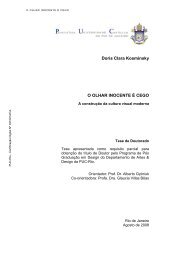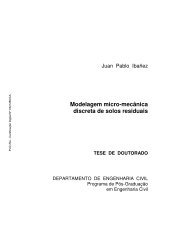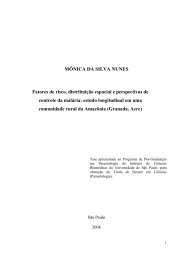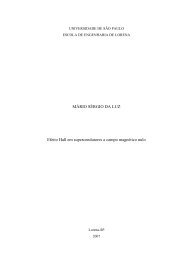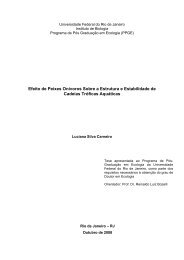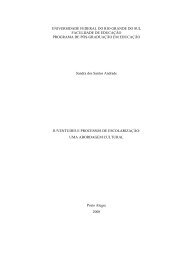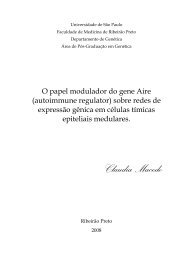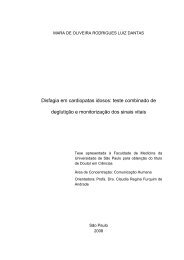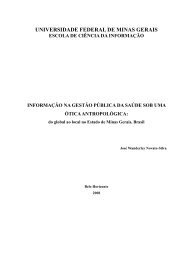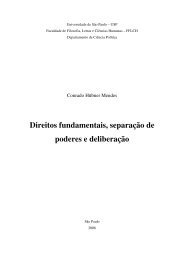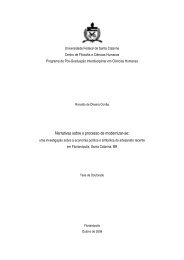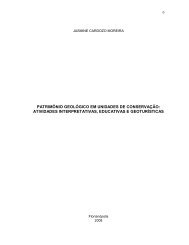Materiais moleculares funcionais contendo n-heterociclos - capes
Materiais moleculares funcionais contendo n-heterociclos - capes
Materiais moleculares funcionais contendo n-heterociclos - capes
Create successful ePaper yourself
Turn your PDF publications into a flip-book with our unique Google optimized e-Paper software.
2852 R. Cristiano et al. / Tetrahedron 63 (2007) 2851–2858H 3 COOHa, bH 3 COOO7OCH 3cdNCNCNNHOOOOHH 3 CO 8 OCH 39NCNCNNcHO 10 OH1, 2, 3 4, 5, 6ef11R 1 = OC 10 H 21NC CNR 1 = OR 2 = H14R 2 = H13R 1 = OC 10 H 15R 1 = O21 R 2 = HR 2 = HOO12 R 1 = R 2 = OC 12 H 25N NOOO16 R 1 = R 2 =R 2R 1 R 2 R 2 R 1R 211-16OOOC 10 H 21OC 12 H 25OC 12 H 25OC 12 H 25OC 12 H 25Scheme 1. Synthetic route for final compounds 11–16. Conditions (yield): (a) KCN, EtOH/H 2 O, reflux (38%); (b) CuSO 4 , pyridine/H 2 O, 60 C (93%);(c) diaminomaleonitrile, TsOH cat. , MeOH, reflux (90%); (d) HBr (aq) , AcOH, reflux (69%); (e) (i) respective carboxylic acid (1, 2,or3), SOCl 2 ,CH 2 Cl 2 , reflux(100%); (ii) TEA, CH 2 Cl 2 , rt (70–85%); (f) respective carboxylic acid (4, 5, or6), DCC, DMAP cat. ,CH 2 Cl 2 , rt (70–85%).group elimination was firstly carried out using BBr 3 ,however,this gave poor yields of compound 10. Thus, anotherapproach was performed, in which anisil 7 was demethylatedby refluxing it in a 1:1 HBr (aq) /acetic acid mixture.This procedure was found to be better, giving diphenol 9,which was reacted with DAMN and p-TsOH cat. affordingcompound 10. The final compounds 11–16 were synthesizedthrough esterification of diphenol 10 with different, previouslyprepared, aromatic carboxylic acids 1–6 shown inFigure 1. Two approaches were used: for carboxylic acids1–3 the reaction was carried out using the freshly preparedacid chloride in the presence of triethylamine in dichloromethane;and for carboxylic acids 4–6, to avoid ester orbenzyl ether cleavage of these acids by thionyl chloride, theesterification was performed with dicyclohexylcarbodiimide(DCC) in the presence of catalytic amount of dimethylaminopyridine(DMAP).The structures of all the compounds were characterizedby IR, 1 H, and 13 C NMR spectra and elemental analysis,including X-ray diffraction analysis of compound 8.2.2. X-ray diffraction analysis of the central coreConsidering the enormous difficulty in crystallizing the finalcompounds 11–16, the well-crystalline intermediate 2,3-dicyanopyrazinederivative 8 was crystallized and analyzedby single crystal X-ray diffraction for a better understandingof the solid state nature of the final molecules, since thesematerials have the same central core. Slightly yellow crystalsof 8 suitable for X-ray analysis were obtained by recrystallizationfrom methanol. The crystal structure and selectedbond lengths and angles of 8 are presented in Figure 2.H 21 C 10 OH 25 C 12 OH 25 C 12 OH 25 C 12 OH 25 C 12 OH 25 C 12 OH 25 C 12 O12OOHOOHOH 21 C 10 OH 21 C 10 OH 25 C 12 OH 25 C 12 OH 25 C 12 OOOHFigure 1. Carboxylic acid intermediates 1–6 synthesized.OO634OOOO5OOHOOHOOH



